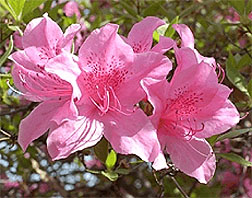This page has been archived and is being provided for reference purposes only. The page is no longer being updated, and therefore, links on the page may be invalid.
|
|
|
|
Hot Water Treatment Eliminates Rhizoctonia from Azalea Cuttings
By Stephanie YaoDecember 23, 2009
Rhizoctonia, a fungal disease that can be found in many ornamental plants, can be eliminated in azalea by placing plant cuttings in a hot water treatment, an Agricultural Research Service (ARS) scientist and his university collaborator have found.
Rhizoctonia web blight is an annual problem in azalea cultivars grown in containerized nursery production in the southern and eastern United States. The fungus lives on all azalea plant surfaces and in the pine bark soil throughout the year, yet only causes plant damage in July and August, when heat and humidity peak.
The disease first affects the azalea’s internal leaves during June, with signs often unseen by the grower. Within 24 hours, the shrub can go from appearing healthy to having one-third of its leaves rapidly turn brown and die.
Rhizoctonia is undetectable to the human eye, which means the pathogen can be carried on stem cuttings used to propagate new plants and circulated within nursery stock for years. Current control efforts include treating plants with fungicide to stop the severe plant damage. However, dipping stem cuttings in a disinfestant or fungicide solution has not controlled spread of the fungus, so better control methods are needed.
In a study published in HortScience, ARS plant pathologist Warren Copes at the agency’s Southern Horticultural Research Laboratory in Poplarville, Miss., and Eugene Blythe, an assistant research professor at Mississippi State University’s South Mississippi Branch Experiment Station at Poplarville, found placing the cuttings in water at 122 degrees Fahrenheit for 20 minutes is the most effective method to eliminate Rhizoctonia without damaging the plant, thus eliminating the need for fungicide treatment. The pathogen can be eliminated in less time when placed in water at higher temperature, but the risk of damaging the cutting increases.
According to Copes, there is still potential for the cuttings to be re-contaminated in other areas of the production process. He is trying to identify which steps pose the most risk for re-contamination, with the goal of maximizing control of this fungal disease with the least amount of effort and expense for producers.
ARS is the principal intramural scientific research agency of the U.S. Department of Agriculture.

